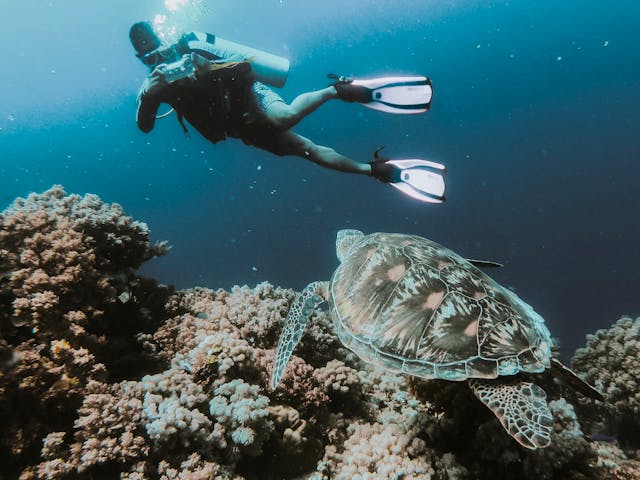How To Take Underwater Photos in the Maldives: Useful Tips for Beginners
Diving in the Maldives is one of the most rewarding and unforgettable experiences to enjoy, as the waters around the archipelago are thriving with picturesque marine ecosystems that are home to some of the most fascinating marine species in the world. One of the best ways to capture these thrilling moments in time is through underwater photography. Despite it being quite a rewarding endeavour, underwater photography requires plenty of practice, skill and patience, especially for beginners. If you are thinking of taking up underwater photography to document your diving excursions in the Maldives, here are some useful tips and steps to follow to get you started.

Photo by Jondave Libiran via pexels
Choose Your Camera Equipment
If you’re just starting out in the realm of underwater photography, it is best to keep things simple. Using a DSLR camera underwater can be difficult to manage due to its bulk, so it is best to start with a point-and-shoot underwater camera which is easier to handle. These cameras capture great photographs with the aid of modern technology. You can switch to a more advanced camera and setup once you get used to the point-and-shoot underwater. If you’re already considering a larger camera make sure to use additional support equipment like port floats or arm floats to balance your camera underwater. You’ll also need to consider other elements like lighting equipment to combat the tricky natural lighting underwater.
Practice Diving with a Camera
Once you’ve sorted all your equipment requirements, you’ll then need to practice manoeuvring and adjusting your camera underwater. One of the biggest challenges you’ll face is mastering buoyancy which is crucial to staying steady when capturing photos. Keep practising your buoyancy control and how to keep your camera still; if you are staying in the Maldives at a resort like Anantara Veli Maldives Resort, you can participate in the guided diving courses and consult experts for tips on managing buoyancy.Additionally, you’ll need to get comfortable with adjusting camera settings underwater. Those like aperture, ISO and shutter speed are all important settings to be familiar with as you’ll need to adjust these settings quite frequently underwater. You can start experimenting with auto-settings and then move on to the manual settings when you’re ready.
Practice Basic Photography Concepts
Just like with regular photography there are a few technical concepts you’ll need to learn for mastering underwater photography and composition is one of these. The Rule of Thirds composition guideline is a good one to follow as it helps to balance your shots and capture your subject well in relation to its environment. You can also try taking photos at an upward angle and moving closer to your subject to give it more prominence in your photos. You should also consider adjusting your camera’s white balance, especially if you plan on venturing deeper below the surface. The deeper you go, the water tends to retain more blue and green colours that can often taint your photography. Adjusting white balance can help counteract this and bring back natural colours to make your photos more realistic.
Be Mindful of the Environment
If you plan on diving near your overwater villa in Maldives, it is important to be mindful of the underwater environment as you’ll likely be in an area that is protected by local authorities. Getting the right shot of your subjects is important but you should take care to avoid disturbing or harassing marine life in order to capture that perfect shot. Also, be mindful when moving in close to your subject as this can distress marine animals; try to use the macro-mode setting on your camera to make up for the distance. Additionally, make sure that your gear doesn’t damage the coral reefs. The reefs are fairly fragile ecosystems and they can take years to rebuild from the slightest damage. As such it is important to be mindful of where you place your equipment and how you handle them, especially if you have additional support elements like trays or floaters.
